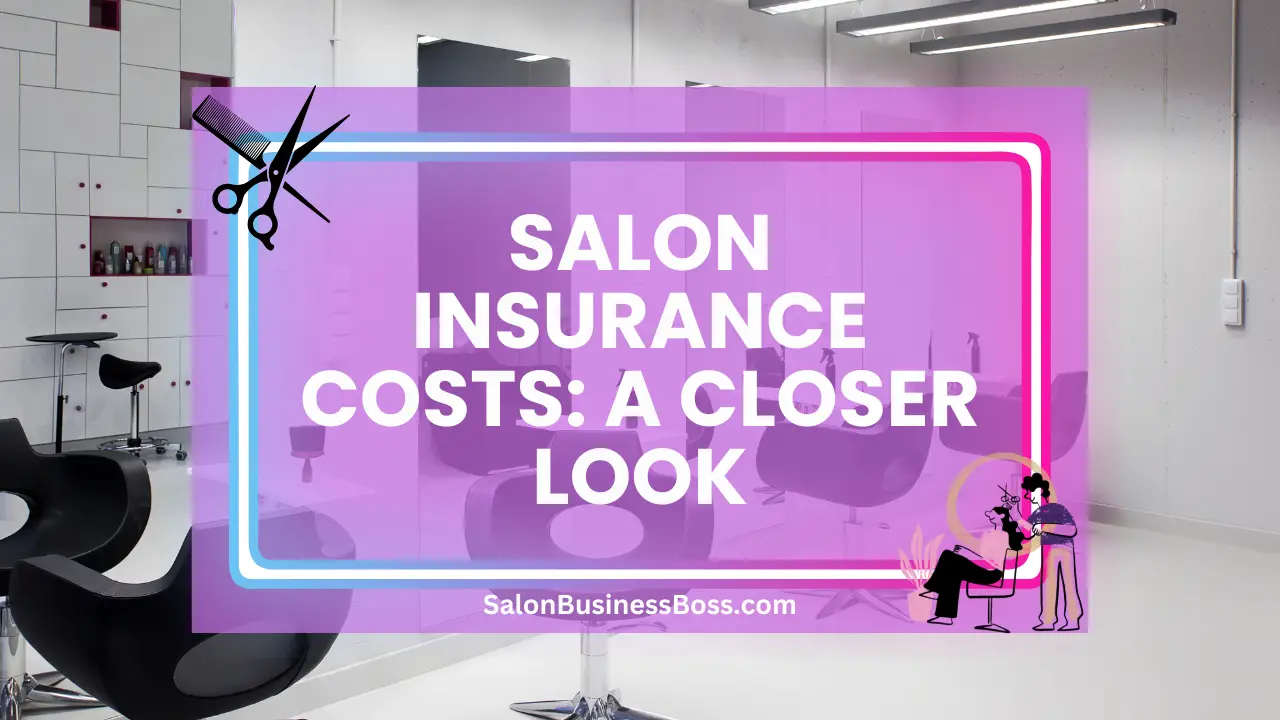Salons play a crucial role in enhancing people’s appearance and confidence. As small businesses, salon owners need to protect their assets and investments by securing the right insurance coverage. Salon insurance provides essential financial protection against unforeseen events and liabilities that may arise during salon operations.
Salon insurance costs about $435 per year, but the price can vary based on factors like salon size, location, and services offered. It includes coverage for general liability, property, and professional liability, protecting the salon from various risks. Salon owners can potentially reduce costs by implementing safety measures and seeking quotes from multiple insurance providers. Adequate insurance safeguards the salon’s assets and allows it to focus on providing quality services to clients.
1. Factors Influencing Salon Insurance Costs
The cost of salon insurance can vary significantly based on several factors. Insurance providers assess these factors to determine the level of risk associated with insuring a particular salon. Some key factors influencing salon insurance costs include:
a. Salon Location:
The geographical location of a salon is a critical factor that insurers carefully assess when determining insurance premiums. Salons situated in high-crime areas or regions prone to natural disasters are perceived as higher-risk locations. High-crime areas increase the likelihood of theft, vandalism, and potential liability claims due to security concerns. Similarly, regions susceptible to natural disasters, like hurricanes or earthquakes, pose risks of property damage and business interruption. Insurance providers consider these factors when calculating premiums, as the likelihood of claims in such areas is higher. Salon owners in these locations should be prepared for relatively higher insurance costs to ensure adequate coverage against potential risks associated with their surroundings.
b. Salon Size and Revenue:
The size of a salon and its annual revenue can significantly influence insurance costs. Larger salons with higher revenues typically possess more assets to protect, such as expensive equipment, furniture, and a larger inventory. Consequently, the potential risk exposure for insurers is greater for larger salons. Additionally, higher revenue often indicates increased foot traffic and a larger client base, which could lead to a higher probability of liability claims. Insurers consider these factors when setting premiums, as the financial stakes are higher for both the salon and the insurance company. Salon owners should carefully assess their salon’s size and revenue to ensure they obtain sufficient coverage that adequately protects their assets and accounts for the risks associated with their business volume.
c. Types of Services Offered:

The range of services offered by a salon is a critical aspect that impacts insurance costs. Salons that provide high-risk services, such as chemical treatments, laser procedures, or other specialized treatments, face elevated liability risks. These services may carry inherent risks of injuries, allergic reactions, or other adverse outcomes, leading to potential claims. As a result, insurance providers consider such salons as higher-risk clients and may charge higher premiums to cover the increased exposure to liability. Salon owners offering these services should prioritize obtaining appropriate professional liability coverage and be prepared for relatively higher insurance costs. On the other hand, salons primarily offering standard beauty services may experience more favorable insurance rates due to lower perceived risks.
Read more about: Different Types of Salons (And Why They Matter)
d. Claims History:
A salon’s past insurance claims history significantly impacts current insurance costs. Insurance providers evaluate a salon’s claims history to assess its risk profile and likelihood of future claims. Frequent claims, regardless of their size, may indicate underlying issues or inadequate risk management practices, leading insurers to perceive the salon as a higher risk. Additionally, a history of large claims can signal potential financial instability and the possibility of future significant claims. In response, insurers may adjust premiums accordingly to mitigate their potential exposure. Salon owners should prioritize risk management practices to minimize claims and maintain a positive claims history, which can lead to more favorable insurance rates in the long run.
e. Safety Measures:
Implementing comprehensive safety measures is not only crucial for the well-being of salon clients and staff but can also have a positive impact on salon insurance costs. Insurance providers view salons with robust safety protocols as lower risk, leading to potentially lower premiums. Installing fire safety systems, such as smoke detectors and sprinklers, reduces the risk of extensive property damage from fire incidents. Security cameras deter theft and vandalism, making the salon a less attractive target for criminal activities. Regular staff training in safety procedures ensures employees are well-prepared to handle emergencies, further reducing the likelihood of accidents and potential liability claims. By investing in safety measures, salon owners not only enhance the overall salon experience but also create a safer environment that can translate into cost savings through reduced insurance premiums.
f. Coverage Limits and Deductibles:
The selection of coverage limits and deductibles plays a significant role in determining salon insurance costs. Opting for higher coverage limits, which increase the maximum amount the insurer will pay for a claim, may lead to higher premiums. Similarly, choosing lower deductibles, the amount the insured must pay before the insurance kicks in, can also result in increased premiums. While it may be tempting to lower deductibles for greater peace of mind, it’s essential to strike a balance between adequate coverage and affordable premiums. Assessing the salon’s specific needs and risk exposure can help determine appropriate coverage limits and deductibles. Engaging in careful cost-benefit analysis and consulting with insurance professionals can aid salon owners in finding an insurance policy that provides optimal coverage at a reasonable cost.
2. Types of Salon Insurance Coverage
Salon insurance typically comprises various types of coverage, each serving a specific purpose in safeguarding the business from potential risks. Some common types of salon insurance coverage include:
a. General Liability Insurance:
General liability insurance is a fundamental coverage that every salon should have. It shields the salon from third-party claims for bodily injury, property damage, or advertising injury that may occur on the premises or due to salon operations. For example, if a client slips and falls in the salon, general liability insurance would cover their medical expenses and any legal fees if they decide to sue. Additionally, if a client claims that a salon product caused an allergic reaction, this coverage would also provide protection. General liability insurance is essential for safeguarding the salon’s reputation and financial stability, as it addresses unforeseen incidents that could lead to costly lawsuits or settlements.
b. Property Insurance:
Property insurance is a critical component of salon insurance as it protects the physical assets of the salon. It provides coverage for damage or loss of the salon’s building, equipment, furniture, and inventory due to perils such as fire, theft, vandalism, or other covered events. For instance, if a fire damages the salon, property insurance would help in repairing or rebuilding the structure and replacing the damaged equipment and furniture. This coverage ensures that the salon can quickly recover and resume operations after an unexpected disaster. Salon owners should carefully evaluate the value of their assets and invest in sufficient property insurance to protect against potential financial losses caused by property damage or theft.
c. Professional Liability Insurance:

Professional liability insurance, also known as malpractice or errors and omissions insurance, is critical for salons that offer beauty services. It provides coverage for claims arising from alleged negligence, errors, or mistakes in providing salon services. If a client claims that a salon employee’s mistake during a treatment caused harm or unsatisfactory results, professional liability insurance would step in to cover legal fees and potential settlements. This coverage not only protects the salon’s financial interests but also reinforces trust with clients by demonstrating a commitment to professional standards and quality service delivery.
Read more about: Salon Insurance Cost: Ensuring Long-term Business Stability
d. Business Interruption Insurance:
Business interruption insurance is a lifeline for salons facing unexpected disruptions. It provides coverage for lost income and ongoing expenses if the salon needs to temporarily close due to a covered event, such as a fire, natural disaster, or other insured perils. The coverage ensures that the salon can continue to meet its financial obligations, such as rent, salaries, and utilities, even during periods of closure. By alleviating the financial strain of business interruptions, this insurance allows salon owners to focus on rebuilding and resuming normal operations as swiftly as possible without facing severe financial setbacks.
e. Workers’ Compensation Insurance:
Workers’ compensation insurance is a legal requirement in many states and is essential for salons with employees. It provides benefits to employees who suffer work-related injuries or illnesses. Coverage includes medical expenses, rehabilitation costs, and lost wages during the recovery period. Workers’ compensation insurance not only protects employees but also shields the salon from potential lawsuits related to workplace injuries. By providing financial support to injured employees, this coverage promotes a safer work environment and helps maintain a positive relationship between the salon and its staff.
f. Product Liability Insurance:
Product liability insurance is critical for salons that sell beauty products. It provides protection against claims resulting from adverse reactions or injuries caused by the products the salon uses or sells. For example, if a client experiences an allergic reaction to a product applied during a treatment, product liability insurance would cover the costs of any resulting medical expenses or legal claims. This coverage is essential for mitigating the financial risks associated with potential product-related incidents and maintaining the salon’s reputation for providing safe and high-quality beauty products to its clients.
3. Strategies to Reduce Salon Insurance Costs
Salon owners can take proactive measures to potentially reduce insurance costs without compromising on coverage quality. Consider the following strategies:
a. Comparison Shopping:
Comparison shopping is a crucial step in finding the most cost-effective salon insurance policy. By obtaining quotes from multiple insurance providers, salon owners can compare coverage options and costs. Different insurers may offer varying rates for similar coverage, so it’s essential to conduct due diligence and examine the fine print of each policy. While comparing prices, it’s equally vital to consider the extent of coverage and any exclusions that may apply. Additionally, online resources and customer reviews can provide valuable insights into insurers’ reputation and customer service. By dedicating time to comparison shopping, salon owners can identify the best insurance option that aligns with their specific needs and budget, ensuring optimal protection for their business.
b. Bundle Policies:
Bundling multiple insurance policies is an effective way to save on salon insurance costs. Many insurance companies offer discounts for combining general liability, property, professional liability, and other necessary coverages into a single comprehensive package. Bundling not only streamlines insurance management but can also lead to significant cost savings. By consolidating policies with one insurer, salon owners may become eligible for loyalty rewards and additional discounts. However, before bundling, it’s essential to review the individual coverage limits and ensure that the overall package adequately addresses the salon’s unique risks. A well-designed bundled insurance policy provides convenience, affordability, and comprehensive protection for the salon’s assets and operations.
c. Risk Management:

Proactive risk management is a powerful strategy for reducing salon insurance costs. Implementing robust safety protocols, such as fire safety systems, security cameras, and regular staff training, can minimize the likelihood of accidents and claims. Safety measures not only protect clients and staff but also demonstrate the salon’s commitment to providing a secure environment. Insurance providers view salons with strong risk management practices as lower risk, leading to potentially lower premiums. Additionally, establishing a safety culture among employees can contribute to better risk awareness and accident prevention. By investing in risk management, salon owners can not only potentially reduce insurance costs but also foster a safer and more productive workplace.
Read more about: How to Run a Successful Hair Salon: Salon Management and Efficiency
d. Raise Deductibles:
Opting for higher deductibles can be a prudent approach to lower insurance premiums. By accepting a greater share of the financial responsibility in the event of a claim, salon owners can secure reduced premium rates. However, it’s crucial to balance cost savings with the ability to afford the higher deductible if a claim arises. Before choosing a higher deductible, salon owners should carefully assess their financial capacity and risk tolerance. For financially stable salons with lower risk exposure, a higher deductible may be a feasible option to manage insurance expenses. On the other hand, salons operating in higher-risk environments or with limited financial reserves may prefer a lower deductible to mitigate the financial burden in case of a claim.
e. Maintain Good Claims History:
A history of few or no insurance claims can lead to lower insurance premiums over time. Insurance providers consider salon owners with a positive claims history as lower-risk clients, which may result in more favorable rates. To maintain a good claims history, salon owners should prioritize risk management practices, implement safety measures, and address potential issues promptly to avoid claims. Regularly reviewing and updating safety protocols can reduce the likelihood of accidents and incidents that may lead to insurance claims. Additionally, prompt and fair resolution of client concerns can also help prevent escalated disputes and potential claims. By cultivating a track record of responsible claims management, salon owners can potentially benefit from long-term cost savings on their insurance premiums.
f. Seek Professional Advice:
Navigating the complexities of salon insurance can be challenging, and seeking professional advice is highly beneficial. Consulting an experienced insurance broker or agent specializing in salon insurance can provide invaluable insights and guidance. These experts understand the unique risks faced by salons and can tailor insurance solutions to meet specific needs. An insurance professional can help salon owners identify potential coverage gaps, explain policy terms, and compare quotes from multiple insurers. They can also help negotiate competitive rates and ensure that the selected insurance policy aligns with the salon’s budget and risk tolerance. With professional advice, salon owners can make informed decisions, secure the right coverage, and obtain the best possible insurance rates for their business.
Conclusion
Salon insurance is a vital investment for salon owners, providing financial protection against unforeseen events and liabilities. The cost of salon insurance is influenced by various factors, including salon location, size, services offered, claims history, and safety measures implemented. Understanding the types of coverage available and exploring strategies to potentially reduce insurance costs can help salon owners make informed decisions and safeguard their businesses effectively. By prioritizing insurance needs and securing adequate coverage, salon owners can focus on providing exceptional services to their clients with peace of mind.
Frequently Asked Questions

1. How can I find the best insurance coverage for my salon?
Consult an experienced insurance broker or agent specializing in salon insurance to help you find the most suitable coverage at competitive rates.
2. Do I need professional liability insurance for my salon?
Yes, professional liability insurance is essential for protecting against claims of negligence or errors in providing salon services.
3. Are product liability and workers’ compensation insurance necessary for my salon?
If your salon sells beauty products or has employees, product liability and workers’ compensation insurance are usually required by law.
To learn more on how to start you own salon checkout my startup documents here.
Please note that the contents of this blog are for informational and entertainment purposes only and should not be construed as legal advice. Any action taken based on the information provided in this blog is solely at your own risk. Additionally, all images used in this blog are generated under the CC0 license of Creative Commons, which means they are free to use for any purpose without attribution.

About the author. Entrepreneur and Salon Business Fan.
Hi! I am Shawn and I am a happy individual who happens to be an entrepreneur. I have owned several types of businesses in my life from a coffee shop to an import and export business to an online review business plus a few more and now I create online salon business resources for those interested in starting new ventures. It’s demanding work but I love it. I do it for those passionate about their business and their goals. That’s why when I meet a salon business owner, I see myself. I know how hard the struggle is to retain clients, find good employees and keep the business growing all while trying to stay competitive.
That’s why I created Salon Business Boss: I want to help salon business owners like you build a thriving business that brings you endless joy and supports your ideal lifestyle.


